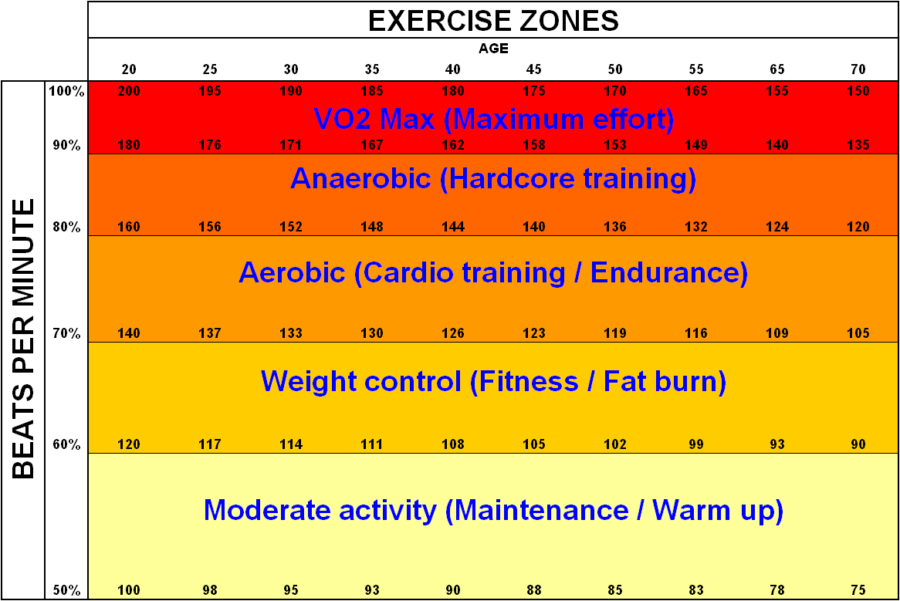Improve Your Performance With Heart Rate Training Zones
Your heart rate indicates your level of effort. In this article we will teach you what heart rate training zones are and how they can help you progress faster.
Heart rate training is a way to use a percentage of your maximal heart rate (measured in beats per minute) to train at a specific effort. Some training would require more effort than others. You check your heart rate using a smart watch, a heart rate monitor or by checking your pulse.
You must be thinking "Why does this matter? All my workouts are intense". After an intense workout, you experience fatigue, which decreases your overall performance because your body is recovering. Once your body has fully recovered (after 2-3 days), your performance would be higher than it used to be. That's progressive overload.
This is why athletes never train at high intensity every day, otherwise they wouldn't be able to perform. They tend to prefer to moderate intensity, since it puts your body under less stress. This applies to anaerobic training (e.g. weight lifting) and aerobic training (e.g. running).
The key is to alternate intensities: high, moderate, light... repeat (depending on your goals).
You will need to calculate your maximum heart rate to define your training zones.
Your maximum heart rate (MHR) can be calculated by this formula:
- Maximum heart rate = 220 beats per minutes - your age.
- For our examples, we will take the example of someone who is 30.
- e.g. MHR = 220 - 30 = 190 beats per minute
The different training zones are percentage of your maximum heart rate:
- Zone 1: Healthy Heart And Recovery Zone
- Target heart rate: 50-60% MHR
- Estimate heart rate (30 year old): 95-114 bpm
- Benefits: Improves overall metabolism and helps with recovery.
- Notes: Good for a rest day.
- Sensations: Feels very easy on your muscles and your breathing. You should be able to talk while doing it.
- Example of activity: Walking.
- Zone 2: Weight Management Zone
- Target heart rate: 60-70% MHR
- Estimate heart rate (30 year old): 114-133 bpm
- Benefits: Helps burn calories and improves endurance.
- Notes: Good for an active recovery day.
- Sensations: Feels comfortable with low muscle load. You would be able to talk while doing it.
- Example of activity: Jogging.
- Zone 3: Aerobic Zone
- Target heart rate: 70-80% MHR
- Estimate heart rate (30 year old): 133-152 bpm
- Benefits: Improves endurance and aerobic power.
- Notes: Most long distance athletes spend most of their training time in this zone. You will also tend to be in this zone if you weight training.
- Sensations: Moderate breathing and medium muscle load. You would be able to talk while doing it.
- Example of activity: Running.
- Zone 4: Anaerobic Zone
- Target heart rate: 80-90% HMR
- Estimate heart rate (30 year old): 152-171 bpm
- Benefits: Improves maximum performance capacity, stamina and burns a lot of calories.
- Notes: Most short distance athletes spend most of their training time in this zone. You will also be in this zone if you play high intensity sports (e.g. hockey, tennis...)
- Sensations: Heavy breathing and moderate to high muscle fatigue. You would struggle to talk.
- Example of activity: Weight lifting.
- Zone 5: Maximum Effort Zone
- Target heart rate: 90-100% HMR
- Estimate heart rate (30 year old): 171-190 bpm
- Benefits: Improves performance, muscle strength and power.
- Notes: Most sports that require sprinting power (e.g. cycling, track...). It's recommended to not spend too much time in this zone, since it creates a lot of fatigue and increases the risk of injury.
- Sensations: Extremely exhausting with heavy breathing. You would not be able to talk.
- Example of activity: Sprinting.
Your heart rate is a great way to measure your efforts. The goal is to use the different heart rate training zones, while putting an emphasis on the type of training you need for your goals.
Here are some examples of training zones for different goals:
- If your goal is to be a long distance runner, your training zones should look like:
- Zone 1-2 (Light Zones): 15%
- Zone 3 (Moderate Zone): 80%
- Zone 4-5 (Hard Zones): 5%
- If your goal is to be a short distance runner, your training zones should look like:
- Zone 1-2 (Light Zones): 10%
- Zone 3 (Moderate Zone): 30%
- Zone 4-5 (Hard Zones): 60%
- If your goal is to be a weight lifter, your training zones should look like:
- Zone 1-2 (Light Zones): 10%
- Zone 4-5 (Hard Zones): 20%
- Zone 3 (Moderate Zone): 70%
Those are examples, these numbers can vary depending on how your goals, your recovery and how your schedule is set up.
Here’s a hybrid plan that will help you build all heart rate training zones:
All you have to keep in mind is that you will need to adjust the training intensity according to your level of fatigue.
Fatigue doesn't have to be muscle related, it can be indirect, like your lifestyle. For example, it would be a risky idea to train at Zone 4-5 if you've only had 4 hours of sleep.
- Heart rate training zones are ways to train using different efforts.
- Your maximum heart rate MHR = 220 - your age.
- It's important to train at different heart training zones according to your fitness goals.
- Adjust your training zones according to your fatigue level.

